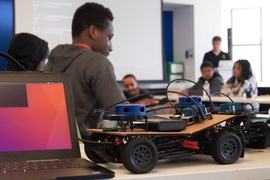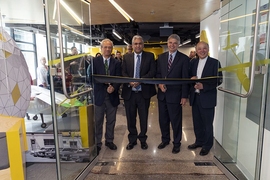Nearly 1,000 students, instructors, and guests packed into MIT's Johnson Ice Rink on Aug. 4 to kick off the final event for the 2019 Beaver Works Summer Institute (BWSI). It was a full day of competitions and demonstrations — the culmination of four weeks of hard work and dedication from the students and staff. The event, held at various locations on MIT campus, was a fitting end to what many of the students described as a transformational experience.
Now in its fourth year, the BWSI offers hands-on STEM learning to rising high school seniors, and now to middle school students, through project-based, workshop-style courses. The program is run jointly by MIT Lincoln Laboratory and the School of Engineering and this year admitted more than 250 students from 27 states and more than 130 schools. This year's BWSI featured 10 courses — Autonomous RACECAR Grand Prix, Autonomous Air Vehicle Racing, Autonomous Cognitive Assistant, Medlytics: Data Science for Health and Medicine, Build a CubeSat, Unmanned Air System–Synthetic Aperture Radar (UAS-SAR), Embedded Security and Hardware Hacking, Hacking a 3-D Printer, Remote Sensing for Crisis Response, and Assistive Technology — plus one middle school RACECAR class.
At the MIT Department of Aeronautics and Astronautics Building 31, teams of students from the UAS-SAR course were challenged to create an image of a covered space with a hidden pattern underneath. To do this, the teams each flew a small UAS around an enclosed room. The UAS was equipped with a radar that the students had built and tested during the course. Afterward, the teams answered visitors' questions and gave informal presentations about their radars.
"In addition to obtaining more hands-on experience, the people that I have met and bonded with made this program a moment in my life that I will never forget," says Swanyee Aung, a student in the UAS-SAR class from the Bronx High School of Science in New York.
Fiona McEvilly, a teaching assistant (TA) for the course, took the UAS-SAR class in 2018 and was excited to return and participate in a different way. "This year I was able to help BWSI grow and expand, and I'm still learning more as a TA this year," she says. “BWSI is such a great opportunity.”
Meanwhile, students from several of the courses displayed their work with posters and demonstrations in the MIT Stratton Student Center (Building W20).
Shuen Wu, a homeschool student from Minnesota who took the Medlytics course, explained his team's work, which was to design a prototype web application that would help physicians and patients identify disease from symptoms and then recommend treatment. The Medlytics course focused on the intersection of data science and medicine, allowing students to apply advanced machine learning and data mining to real-world medical challenges. "I really like the fact that we spent a lot of time actually working on projects," Wu says. "The best way to learn coding and statistics is to just do it."
One team of students from the Build a CubeSat course designed and constructed a prototype of a CubeSat called SLOOP that would inform people responding to oil spills about how to take action quickly and efficiently. "We learned a lot about how spacecraft and satellites are built and got to experience building something faithful to an actual spacecraft," says Kemal Pulungan, a student from Troy High School in New York.
Back in the Johnson Athletics Center, two floors above the ice rink, students from the Autonomous Air Vehicle Racing class completed an obstacle course race made of bridges and rings hanging at different heights in the air. Each team developed algorithms that allowed an Intel drone to autonomously navigate the race course. The winning team completed the course in one minute and 32 seconds.
In the afternoon, the BWSI students, staff, and guests gathered again in the Johnson Ice Rink to watch the RACECAR grand prix. RACECAR was the very first course offered in BWSI — and remains the largest course, with 57 students enrolled this year. For this event, the ice rink was converted into a racetrack with obstacles such as a graveyard, car wash, and giant windmill. Students programmed RACECARs (Rapid Autonomous Complex Environment Competing Ackermann-steering Robots), designed by MIT and Lincoln Laboratory, to navigate the track by using inertial sensors, lidar, and cameras.
This year was the first that middle school students were admitted to a modified version of the RACECAR course. Their course is based on the high school version, with students learning software coding and controls for programming their own RACECAR vehicles.
"This was a real opportunity for middle school students to be exposed to the basics of programming, computational thinking, computer vision, and robotics," says Sabina Chen, the middle school RACECAR instructor and an MIT graduate student. "Throughout the program, students were encouraged to think critically and work as a team to complete complex coding challenges. BWSI RACECAR Middle School may be one of the few programs that currently exist to teach not only computer programming, but also computer vision and autonomous driving, to students at this age."
In his opening remarks, Robert Shin, the director of Beaver Works and head of the Intelligence, Surveillance, and Reconnaissance and Tactical Systems Division at MIT Lincoln Laboratory, challenged the outgoing students to keep the ball rolling by becoming mentors to the next generation of engineers. One goal of BWSI is to continue expanding to bring the program to more and more students across the country and the world. In line with this goal, this year's program included teams from Mexico participating in the RACECAR and CogWorks courses and a team from Nauset High School on Cape Cod competing in RACECAR. In addition, the Ulsan National Institute of Science and Technology in South Korea provided TAs to several BWSI courses and plans to adopt the BWSI curriculum next year.
"I know it’s a cliché to say that BWSI was a transformational experience, but that's honestly the best description for my time here," says Emily Amspoker, a student in the Embedded Security and Hardware Hacking course from Kent Denver School in Colorado. "Before I started the online part of my course, I knew very little about the subject. Fortunately, throughout both the online and in-person class, I've learned more about embedded systems and cybersecurity than I could have fathomed just a couple of months ago. More importantly, I feel like I've grown to become a better teammate and person by collaborating and overcoming problems with students from across the country who are also passionate about STEM."













